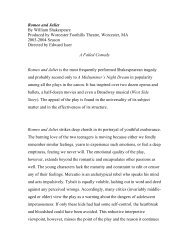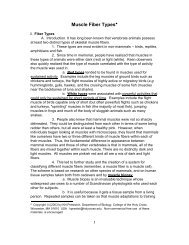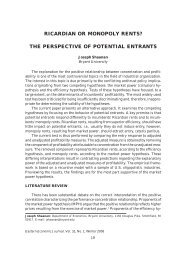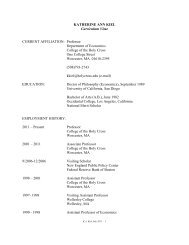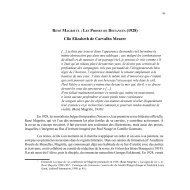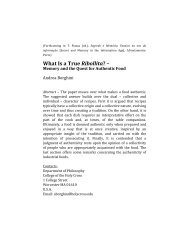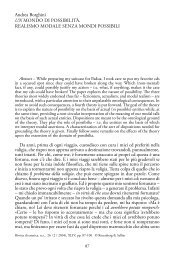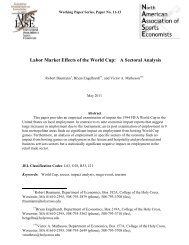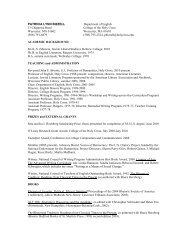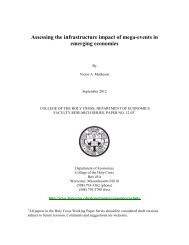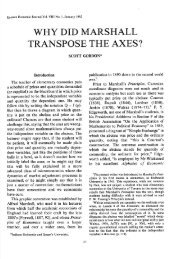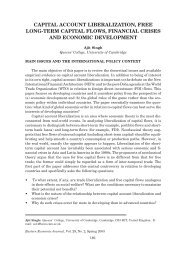club objectives and ticket pricing in professional team sports
club objectives and ticket pricing in professional team sports
club objectives and ticket pricing in professional team sports
You also want an ePaper? Increase the reach of your titles
YUMPU automatically turns print PDFs into web optimized ePapers that Google loves.
CLUB OBJECTIVES AND TICKET PRICING<br />
IN PROFESSIONAL TEAM SPORTS<br />
INTRODUCTION<br />
Prof. dr. Stefan Késenne<br />
University of Antwerp <strong>and</strong> Catholic University of Leuven<br />
<strong>and</strong><br />
Prof. dr. Wilfried Pauwels<br />
University of Antwerp<br />
An important question <strong>in</strong> the literature of <strong>professional</strong> <strong>team</strong> <strong>sports</strong> is whether<br />
<strong>club</strong>s are profit maximizers or utility maximizers [Rothenberg, 1956; Sloane, 1971]. It<br />
turns out that these different <strong>objectives</strong> have serious implications for the <strong>club</strong>’s talent<br />
dem<strong>and</strong>, the competitive balance <strong>in</strong> the league, the player salary level <strong>and</strong> the <strong>ticket</strong><br />
price, as well as for the impact of market regulations such as player transfer systems<br />
<strong>and</strong> <strong>club</strong> revenue shar<strong>in</strong>g arrangements [Kesenne, 1996; 2000; Rascher, 1997; Fort<br />
<strong>and</strong> Quirk, 2004]. Some empirical evidence from the US major leagues confirms the<br />
hypothesis that the <strong>club</strong> owners’ ma<strong>in</strong> objective is profit maximization [Demmert,<br />
1973; Noll, 1974; Quirk <strong>and</strong> El Hodiri, 1974; Jones, 1969; Ferguson, Stewart, Jones<br />
<strong>and</strong> Le Dressay, 1991, Fort, 2003]. These empirical tests are ma<strong>in</strong>ly based on the<br />
<strong>pric<strong>in</strong>g</strong> rule or the size of the estimated <strong>ticket</strong> price elasticity. However, it can easily<br />
be derived that the <strong>pric<strong>in</strong>g</strong> rules of a w<strong>in</strong> maximiz<strong>in</strong>g <strong>club</strong> <strong>and</strong> a profit maximiz<strong>in</strong>g <strong>club</strong><br />
are exactly the same, so that the outcome of these tests supports the w<strong>in</strong> maximization<br />
hypothesis as well [Salant, 1992, Fort <strong>and</strong> Quirk, 2004].<br />
The general perception is that European <strong>club</strong>s behave more like utility or w<strong>in</strong><br />
maximizers, but also some well-known US <strong>sports</strong> economists, such as Quirk <strong>and</strong> El-<br />
Hodiri [1974], wrote a long time ago: “The assumption that the actions of franchise<br />
owners are motivated solely by profits from operation of their franchises is admittedly<br />
somewhat unrealistic. Own<strong>in</strong>g a major league franchise carries with it prestige <strong>and</strong><br />
publicity, <strong>and</strong> a wealthy owner might view it simply as a type of consumption; for such<br />
a <strong>sports</strong>man owner, w<strong>in</strong>n<strong>in</strong>g games rather than mak<strong>in</strong>g money might be the motivat<strong>in</strong>g<br />
factor”. More recently, Zimbalist [2003] concluded from his discussion on <strong>club</strong><br />
<strong>objectives</strong> that: “owners maximize global, long-term returns <strong>and</strong> that these are very<br />
different from a <strong>team</strong>’s reported annual operat<strong>in</strong>g profits”. So, also <strong>in</strong> the US major<br />
leagues the question l<strong>in</strong>gers whether <strong>club</strong>s are profit maximizers or w<strong>in</strong> maximizers,<br />
or a comb<strong>in</strong>ation of both [Rascher, 1997].<br />
Start<strong>in</strong>g from the profit maximization hypothesis, much research has been done<br />
on talent dem<strong>and</strong>, competitive balance <strong>and</strong> salary levels [Fort <strong>and</strong> Quirk, 1995;<br />
Stefan Kesenne: Department of Economics, University of Antwerp, Pr<strong>in</strong>sstraat, 13-B2000, Antwerp,<br />
Belgium. E-mail: stefan.kesenne@ua.ac.be.<br />
Eastern Economic Journal, Vol. 32, No. 3, Summer 2006<br />
549
550<br />
EASTERN ECONOMIC JOURNAL<br />
Szymanski, 2002]. Kesenne [1996, 2000] <strong>and</strong> Ford <strong>and</strong> Quirk [2004] show that, under<br />
the w<strong>in</strong> maximization hypothesis, the dem<strong>and</strong> for talent <strong>and</strong> the <strong>ticket</strong> price are higher,<br />
lead<strong>in</strong>g to a worse competitive balance. Beside dem<strong>and</strong> for talent <strong>and</strong> competitive<br />
balance, also gate <strong>ticket</strong> <strong>pric<strong>in</strong>g</strong> has been studied. Noll [1974], Heilmann <strong>and</strong> Wendl<strong>in</strong>g<br />
[1976], Scully [1989] <strong>and</strong> Salant [1992], among others, analyzed the optimum <strong>pric<strong>in</strong>g</strong><br />
strategies of profit maximiz<strong>in</strong>g owners, <strong>in</strong>clud<strong>in</strong>g several revenue sources <strong>and</strong> add<strong>in</strong>g<br />
stadium capacity restrictions. All found <strong>ticket</strong> prices that are set <strong>in</strong> the <strong>in</strong>elastic range<br />
of the dem<strong>and</strong> curve. In a recently published article, Fort [2004] explores these empirical<br />
f<strong>in</strong>d<strong>in</strong>gs <strong>and</strong> shows the logic for <strong>in</strong>elastic gate <strong>pric<strong>in</strong>g</strong>.<br />
To the best of our knowledge, all these studies start from models with only one<br />
decision variable, talent dem<strong>and</strong> or <strong>ticket</strong> price, keep<strong>in</strong>g the other variable constant.<br />
Our contribution to this literature is that we start from a model with two decision<br />
variables: talent dem<strong>and</strong> <strong>and</strong> <strong>ticket</strong> price, under both the profit <strong>and</strong> the w<strong>in</strong> maximization<br />
hypothesis. We assume that <strong>team</strong> managers have to decide simultaneously, at<br />
the start of the season, how many talents they will hire <strong>and</strong> what <strong>ticket</strong> price they will<br />
charge. It is obvious that the <strong>ticket</strong> price affects revenue <strong>and</strong> that the <strong>club</strong> budget<br />
affects the talents they can afford <strong>and</strong>, vice versa: that the number of talents affect<br />
<strong>ticket</strong> dem<strong>and</strong> <strong>and</strong> <strong>ticket</strong> price. This approach challenges a few well-known conclusions<br />
from economic research such as, ‘a stadium capacity constra<strong>in</strong>t results <strong>in</strong> a<br />
higher optimal <strong>ticket</strong> price’ or ‘higher players salaries do not affect the optimal <strong>ticket</strong><br />
price if the marg<strong>in</strong>al cost of spectators is zero’, as well as the impact of some market<br />
regulations, such as impos<strong>in</strong>g salary caps.<br />
In what follows, we start with the comparison of the profit <strong>and</strong> the w<strong>in</strong> maximiz<strong>in</strong>g<br />
hypothesis <strong>in</strong> a model that takes <strong>in</strong>to account the simultaneous management<br />
decisions on <strong>ticket</strong> price <strong>and</strong> talent dem<strong>and</strong>. This is done <strong>in</strong> the second section. The<br />
next section analyses the impact of a stadium capacity restriction on <strong>ticket</strong> price <strong>and</strong><br />
talent dem<strong>and</strong>. In the follow<strong>in</strong>g section, policy implications such as impos<strong>in</strong>g maximum<br />
<strong>ticket</strong> prices, impos<strong>in</strong>g salary caps <strong>and</strong> grant<strong>in</strong>g a government subsidy are considered.<br />
The last section concludes.<br />
THE PROFIT VERSUS THE WIN MAXIMIZATION HYPOTHESIS<br />
In this section we develop a model of <strong>professional</strong> <strong>team</strong> <strong>sports</strong> compar<strong>in</strong>g both<br />
optimal <strong>ticket</strong> prices <strong>and</strong> talent dem<strong>and</strong> <strong>in</strong> the profit <strong>and</strong> the w<strong>in</strong> maximization scenario.<br />
After specify<strong>in</strong>g the model, we <strong>in</strong>troduce profit <strong>and</strong> w<strong>in</strong> maximization <strong>and</strong> compare<br />
the outcomes, us<strong>in</strong>g some clarify<strong>in</strong>g graphical presentations. A comparative statics<br />
analysis allows us to derive the impact of the salary level <strong>and</strong> the size of the<br />
market.<br />
Maximiz<strong>in</strong>g the w<strong>in</strong>n<strong>in</strong>g percentage of a <strong>team</strong>, as a special case of utility maximization,<br />
is a rather specific but not unrealistic objective for <strong>professional</strong> <strong>sports</strong> <strong>club</strong>s. It<br />
should be clear that the w<strong>in</strong> maximization model does not completely disregard profits<br />
or losses. Only, profits are not maximized <strong>in</strong> this approach, because <strong>club</strong>s have also<br />
other <strong>objectives</strong> such as w<strong>in</strong>n<strong>in</strong>g. If we assume a <strong>club</strong> to be ma<strong>in</strong>ly <strong>in</strong>terested <strong>in</strong><br />
sportive success, which means try<strong>in</strong>g to w<strong>in</strong> the championship or as many games as<br />
possible, the only way to reach that goal is to hire as much play<strong>in</strong>g talent as possible,
CLUB OBJECTIVES AND TICKET PRICING<br />
551<br />
with<strong>in</strong> the limits of the (expected) budget, or given a fixed profit rate that is needed to<br />
satisfy the owners or the shareholders, or to f<strong>in</strong>ance stadium <strong>in</strong>vestments or talent<br />
development. As far as a rich <strong>club</strong> owner considers his favorite sport as a consumption<br />
activity, he can as well be prepared to put <strong>in</strong> some of his money with no expected<br />
return. Also this situation can be h<strong>and</strong>led by the w<strong>in</strong> maximization approach.<br />
The most important assumptions that are generally made <strong>in</strong> the literature on<br />
<strong>professional</strong> <strong>team</strong> <strong>sports</strong> are that <strong>club</strong>s are local monopolists <strong>and</strong> price-makers on the<br />
product market. Clubs are wage-takers on the player labor market. The unit cost of a<br />
play<strong>in</strong>g talent is determ<strong>in</strong>ed by dem<strong>and</strong> <strong>and</strong> supply on a ‘free agency’ player labor<br />
market or on a competitive transfer market where players are traded by the owners.<br />
S<strong>in</strong>ce the marg<strong>in</strong>al cost of spectators is very small, it is assumed to be zero. We also<br />
start the analysis by mak<strong>in</strong>g the assumption that there are no stadium capacity restrictions,<br />
which is a simplify<strong>in</strong>g assumption that will be dropped <strong>in</strong> the next section.<br />
Under these hypotheses the follow<strong>in</strong>g dem<strong>and</strong> function for stadium <strong>ticket</strong>s can be<br />
specified<br />
(1) A = A( m, p, l )<br />
with A > 0 A < 0 A > 0 A < 0 A > 0 A > 0 A = 0 .<br />
m p l ll pm lm pl<br />
A is a <strong>club</strong>s’ season attendance, p is the <strong>ticket</strong> price, l is a <strong>team</strong>’s play<strong>in</strong>g talent <strong>and</strong> m<br />
is the size of the market. Subscripts are used to <strong>in</strong>dicate first partial derivatives. We<br />
assume that the size of the market, which determ<strong>in</strong>es the draw<strong>in</strong>g potential of a <strong>club</strong>,<br />
cannot be changed by <strong>club</strong> management. The empirical evidence shows that large<br />
market <strong>club</strong>s have more spectators than small market <strong>club</strong>s (A m >0). The dem<strong>and</strong> for<br />
stadium <strong>ticket</strong>s is assumed to be a downward slop<strong>in</strong>g function of the <strong>ticket</strong> price (A p 0). For a further discussion of this important constantsupply<br />
issue, we refer to Szymanski <strong>and</strong> Kesenne [2004]. It cannot be denied that also<br />
the closeness of the competition or the so-called ‘uncerta<strong>in</strong>ty of outcome’ affects the<br />
<strong>in</strong>terest of spectators <strong>and</strong> the <strong>club</strong>s’ revenue. We therefore assume that play<strong>in</strong>g talent<br />
has a positive but decreas<strong>in</strong>g marg<strong>in</strong>al effect on a <strong>club</strong>’s season attendance (A ll
552<br />
EASTERN ECONOMIC JOURNAL<br />
about the sign of A pl , <strong>and</strong> because there seems to be no obvious reason for it to be<br />
large <strong>in</strong> positive or negative sense, we assume it to be zero, which implies that the<br />
<strong>ticket</strong> dem<strong>and</strong> function is strongly separable <strong>in</strong> <strong>ticket</strong> price <strong>and</strong> talent.<br />
The season revenue of a modern <strong>professional</strong> <strong>sports</strong> <strong>club</strong> not only consists of gate<br />
receipts, but also <strong>in</strong>creas<strong>in</strong>gly depends on broadcast<strong>in</strong>g rights, sponsor<strong>in</strong>g <strong>and</strong> merch<strong>and</strong>iz<strong>in</strong>g.<br />
However, there exists a strong positive correlation between a <strong>club</strong>’s stadium<br />
attendance <strong>and</strong> most of its other revenues. Sponsors are more <strong>in</strong>terested <strong>in</strong> a<br />
successful <strong>club</strong> <strong>and</strong> television companies prefer to broadcast games that are watched<br />
by many people. Also, the merch<strong>and</strong>iz<strong>in</strong>g bus<strong>in</strong>ess profits from a large number of<br />
spectators. The possible negative effect that broadcast<strong>in</strong>g a game might have on stadium<br />
attendance is too small to offset this dom<strong>in</strong>ant positive correlation. Therefore,<br />
we assume that all nongate revenues are proportional to the number of attendances<br />
with proportionality factor q. This simplify<strong>in</strong>g assumption does not take <strong>in</strong>to account<br />
possible complications that arise when <strong>club</strong>s receive local television rights [Fort <strong>and</strong><br />
Quirk, 1995; Vrooman, 1995], it actually reduces the approach to a model that is<br />
almost identical to a gate-only world. So, total <strong>club</strong> revenue R can be written as<br />
(2) R = (p + q)A<br />
A <strong>club</strong>’s total cost C consists of labor <strong>and</strong> non-labor costs. In a free agency system, the<br />
unit cost of a play<strong>in</strong>g talent is the wage per play<strong>in</strong>g talent (w). The capital cost (c 0 ) is<br />
considered to be constant <strong>in</strong> the short run.<br />
If <strong>club</strong>s are profit maximizers we can write the profit function as<br />
(3) π =(p + q)A− wl− c 0<br />
The first-order conditions for a maximum are<br />
(4) π p =(p + q)A p + A = 0<br />
(5) π l =(p + q)A l − w = 0<br />
From equation (4), which is the <strong>pric<strong>in</strong>g</strong> rule, it can be easily derived that the price<br />
elasticity is smaller than unity. In equation (5) we see that a <strong>team</strong> will hire play<strong>in</strong>g<br />
talent until marg<strong>in</strong>al revenue equals marg<strong>in</strong>al cost. The second-order condition for a<br />
maximum requires the Hessian matrix to be negative def<strong>in</strong>ite, so that the follow<strong>in</strong>g<br />
<strong>in</strong>equalities must hold:<br />
2<br />
(6) π < 0 π < 0 π π − π > 0<br />
where<br />
pp ll ll pp pl
CLUB OBJECTIVES AND TICKET PRICING<br />
= ( p+ q) A < 0<br />
(7) π ll ll<br />
(8) π pp = ( p+ q) App + 2Ap< 0<br />
(9) π = π = ( p+ q) A + A = A > 0<br />
pl lp pl l l<br />
We can now illustrate these conditions graphically. From the total differential of the<br />
equations (4) <strong>and</strong> (5) we can f<strong>in</strong>d the slopes of the locus <strong>and</strong> <strong>in</strong> the p-l diagram:<br />
(10)<br />
(11)<br />
dl<br />
π<br />
dp p<br />
dl<br />
= =− ><br />
π<br />
pp<br />
0<br />
π pl<br />
π<br />
0<br />
dp l pl<br />
π = o<br />
π ll<br />
=− >0<br />
553<br />
Given the properties of dem<strong>and</strong> equation (1) <strong>and</strong> the second-order conditions <strong>in</strong> equations<br />
(6), both slopes are clearly positive. From the second-order conditions, we can<br />
also derive that the slope of the locus π p =0 is steeper than the slope of the locus π l =0.<br />
This is shown graphically <strong>in</strong> Figure 1. The two first-order conditions for profit maximization<br />
are met <strong>in</strong> the po<strong>in</strong>t of <strong>in</strong>tersection E 1 of the two loci, which marks the optimal<br />
price level p 1 <strong>and</strong> the optimal number of play<strong>in</strong>g talents l 1 .<br />
l<br />
l 2<br />
l 1<br />
FIGURE 1<br />
Profit <strong>and</strong> w<strong>in</strong> maximiz<strong>in</strong>g equilibrium<br />
π = 0<br />
E 1<br />
P 1<br />
E 2<br />
P 2<br />
π = 0<br />
p<br />
π = 0<br />
l<br />
P
554<br />
EASTERN ECONOMIC JOURNAL<br />
Turn<strong>in</strong>g to the comparative statics analysis, <strong>in</strong> order to derive the impact of an<br />
exogenous change <strong>in</strong> player salary on <strong>ticket</strong> price <strong>and</strong> talent dem<strong>and</strong>, <strong>and</strong> differentiat<strong>in</strong>g<br />
the first-order conditions <strong>in</strong> equations (4) <strong>and</strong> (5) with respect to the unit cost of<br />
talent w, one can f<strong>in</strong>d that<br />
(12)<br />
(13)<br />
∂<br />
∂ =−<br />
p π pl<br />
<<br />
w ππ − π 2 0<br />
ll pp pl<br />
∂<br />
∂ =<br />
l π pp<br />
<<br />
w ππ − π 2 0<br />
ll pp pl<br />
Contrary to what is generally claimed by many American <strong>club</strong> owners, who argue<br />
that player salaries have to be kept low <strong>in</strong> order to keep the <strong>ticket</strong> prices low, a higher<br />
salary level turns out to reduce the optimal <strong>ticket</strong> price <strong>in</strong> the profit maximiz<strong>in</strong>g<br />
scenario. The reason is that a higher salary reduces the dem<strong>and</strong> for talent, which<br />
causes the dem<strong>and</strong> curve for <strong>ticket</strong>s to shift to the left so that the profit (or revenue)<br />
maximiz<strong>in</strong>g <strong>ticket</strong> price will be set at a lower level. In Figure 1, a higher salary level<br />
will shift the locus π l = 0 down so that the optimal <strong>ticket</strong> price <strong>and</strong> talent dem<strong>and</strong> will<br />
be lower. Apply<strong>in</strong>g the envelope theorem to profit function (3), it follows that higher<br />
player salaries reduce owner profits. This is probably the real reason why owners are<br />
talk<strong>in</strong>g player salaries down.<br />
The comparative statics analysis also confirms that large market <strong>club</strong>s hire more<br />
talents <strong>and</strong> charge higher <strong>ticket</strong> prices than small market <strong>club</strong>s. In Figure 1, a larger<br />
value of m will shift the locus π l = 0 to the left <strong>and</strong> the locus π p = 0 to the right so<br />
that, at the new po<strong>in</strong>t of <strong>in</strong>tersection, both the <strong>ticket</strong> price <strong>and</strong> the dem<strong>and</strong> for talent<br />
are higher.<br />
Turn<strong>in</strong>g to the w<strong>in</strong> maximiz<strong>in</strong>g scenario, a <strong>club</strong>’s objective is to maximize the<br />
season w<strong>in</strong>n<strong>in</strong>g percentage, which can only be done by maximiz<strong>in</strong>g the number of<br />
play<strong>in</strong>g talents. It is not necessary to stick to the breakeven constra<strong>in</strong>t, because the<br />
constant capital cost (c 0 ) can also <strong>in</strong>clude a certa<strong>in</strong> amount of positive or negative<br />
profits. Because the capital stock is constant <strong>in</strong> the short run, a constant amount of<br />
profits also means a fixed profit rate. So, we no longer assume that <strong>club</strong>s are profit<br />
maximizers, but that they can be profitable, break even or make a loss. In this approach<br />
we follow the model <strong>in</strong>troduced by Kesenne [1996, 2000], realiz<strong>in</strong>g that add<strong>in</strong>g<br />
this constra<strong>in</strong>t is a simplification because it does not allow the (utility maximiz<strong>in</strong>g)<br />
owner preferences to enter the analysis. Our aim is only to f<strong>in</strong>d out how the results<br />
change if two decision variables are <strong>in</strong>troduced <strong>in</strong> this model.<br />
If <strong>club</strong>s maximize the number of play<strong>in</strong>g talents l under the follow<strong>in</strong>g restriction<br />
0<br />
(14) ( p+ q) A−wl− c = 0
CLUB OBJECTIVES AND TICKET PRICING<br />
the first-order conditions for w<strong>in</strong> maximization can be written as<br />
(15) ( p+ q) A + A =0<br />
(16) ( p+ q) Al= w−<br />
1<br />
λ<br />
0<br />
(17) ( p+ q) A−wl− c = 0<br />
p<br />
555<br />
where λ is the positive Lagrange multiplier. Equation (15) is the <strong>pric<strong>in</strong>g</strong> rule which<br />
turns out to be exactly the same as under the profit maximization hypothesis. From<br />
equation (16) it can be seen that a w<strong>in</strong> maximiz<strong>in</strong>g <strong>club</strong> will hire play<strong>in</strong>g talent up to a<br />
po<strong>in</strong>t where marg<strong>in</strong>al revenue is lower than marg<strong>in</strong>al cost.<br />
In order to compare the optimal price level <strong>and</strong> number of play<strong>in</strong>g talents under<br />
the profit <strong>and</strong> w<strong>in</strong> maximiz<strong>in</strong>g hypothesis we try to f<strong>in</strong>d the iso-profit contours <strong>in</strong> the<br />
p,l-diagram. From the total differential of the profit function <strong>in</strong> equation (3) we f<strong>in</strong>d<br />
that the slope of the iso-profit contours through a po<strong>in</strong>t (p,l) is given by:<br />
(18)<br />
dl<br />
dp<br />
dπ= o =−<br />
It follows that this slope is zero for all po<strong>in</strong>ts (p,l) where π p =0 <strong>and</strong> is <strong>in</strong>f<strong>in</strong>ite for all<br />
po<strong>in</strong>ts (p,l) where π l =0. The iso-profit contours can now be added to the graphical<br />
presentation of the first-order conditions. One of these contours is the zero-profit<br />
contour. If a <strong>club</strong> maximizes the number of talents under the restriction of a fixed<br />
profit rate, the equilibrium po<strong>in</strong>t is E 2 <strong>in</strong> Figure 1 with price p 2 <strong>and</strong> play<strong>in</strong>g talent l 2 . It<br />
turns out that both the dem<strong>and</strong> for play<strong>in</strong>g talent <strong>and</strong> the <strong>ticket</strong> price are higher <strong>in</strong> a<br />
w<strong>in</strong> maximiz<strong>in</strong>g <strong>club</strong>.<br />
From the comparative statics analysis, it can be derived that also <strong>in</strong> the w<strong>in</strong> maximiz<strong>in</strong>g<br />
scenario the impact of the salary level on talent <strong>and</strong> <strong>ticket</strong> price is negative<br />
<strong>and</strong> that the impact of the size of the market is positive. So, this result turns out to be<br />
robust.<br />
STADIUM CAPACITY RESTRICTIONS<br />
In the more simplified model, where <strong>club</strong>s only determ<strong>in</strong>e the optimal <strong>ticket</strong> price<br />
given a constant talent dem<strong>and</strong>, it is obvious that a higher <strong>ticket</strong> price can be set if the<br />
<strong>club</strong> faces a stadium capacity restriction. The more <strong>in</strong>terest<strong>in</strong>g question is how a<br />
stadium capacity restriction affects both the optimal <strong>ticket</strong> price <strong>and</strong> the dem<strong>and</strong> for<br />
talent <strong>in</strong> a profit <strong>and</strong> <strong>in</strong> a w<strong>in</strong> maximiz<strong>in</strong>g league. A stadium capacity restriction can<br />
be written as<br />
π p<br />
π<br />
l
556<br />
EASTERN ECONOMIC JOURNAL<br />
0 −1<br />
0<br />
(19) A ≥ A( m, p, l) or l ≤ A ( m, p, A )<br />
where A 0 is the capacity of the stadium. In Figure 2 this restriction can be drawn as an<br />
upward slop<strong>in</strong>g l<strong>in</strong>e <strong>in</strong> the p - l diagram, where only the po<strong>in</strong>ts below the l<strong>in</strong>e are<br />
feasible. If the constra<strong>in</strong>t is b<strong>in</strong>d<strong>in</strong>g, the new equilibrium for a profit maximiz<strong>in</strong>g <strong>club</strong><br />
is found at the po<strong>in</strong>t of tangency between this restriction <strong>and</strong> the highest possible isoprofit<br />
curve. Given the properties of the <strong>ticket</strong> dem<strong>and</strong> function, this restriction can<br />
be a convex function. A sufficient condition for the capacity constra<strong>in</strong>t to be convex is<br />
that A pp ≤ 0. However, this does not cause any problem because the second order<br />
conditions are satisfied. The first order conditions can be written as<br />
(20) ( p+ q− μ) A + A = 0<br />
(21) ( p+ q−μ) A − w=<br />
0<br />
(22) 0<br />
A − A = 0<br />
where μ is the positive Lagrange multiplier. Compar<strong>in</strong>g these conditions with the<br />
unconstra<strong>in</strong>ed model reveals that it is theoretically undeterm<strong>in</strong>ed whether the level<br />
of the <strong>ticket</strong> price <strong>and</strong> the dem<strong>and</strong> for talent is higher or lower than <strong>in</strong> the unconstra<strong>in</strong>ed<br />
profit maximiz<strong>in</strong>g model.<br />
l<br />
l 2<br />
l 1<br />
FIGURE 2<br />
Stadium Capacity Restriction<br />
π = 0<br />
E 1<br />
P 1<br />
p<br />
l<br />
E 2<br />
P 2<br />
π = 0<br />
p<br />
−1<br />
0<br />
l =<br />
A ( m, p, A )<br />
π = 0<br />
l<br />
P
CLUB OBJECTIVES AND TICKET PRICING<br />
For a w<strong>in</strong> maximiz<strong>in</strong>g <strong>club</strong> the impact of a capacity restriction is different. Given<br />
the two constra<strong>in</strong>ts to the maximization of the w<strong>in</strong>n<strong>in</strong>g percentage:<br />
0<br />
(23) ( p+ q) A−wl− c = 0<br />
(24) 0<br />
A − A = 0<br />
557<br />
the optimal <strong>ticket</strong> price <strong>and</strong> dem<strong>and</strong> for talent can be found at the upper <strong>in</strong>tersection<br />
po<strong>in</strong>t E 2 of the capacity constra<strong>in</strong>t <strong>and</strong> the zero-profit contour <strong>in</strong> Figure 2. It follows<br />
that, <strong>in</strong> the case of a b<strong>in</strong>d<strong>in</strong>g capacity restriction, the dem<strong>and</strong> for talent will always be<br />
lower than <strong>in</strong> the case of no capacity restriction. The optimal <strong>ticket</strong> price can be<br />
higher if a capacity restriction is imposed, but it will come down when the capacity is<br />
further reduced, i.e. when the curve represent<strong>in</strong>g the capacity constra<strong>in</strong>t moves southeast.<br />
The comparative statics analysis tells us that the impact of a chang<strong>in</strong>g salary level<br />
is aga<strong>in</strong> negative on both the optimal <strong>ticket</strong> price <strong>and</strong> the dem<strong>and</strong> for talent. Also a<br />
larger market size leads to a higher <strong>ticket</strong> price <strong>and</strong> talent dem<strong>and</strong>.<br />
SOME POLICY IMPLICATIONS<br />
A first policy implication of these results is that some price regulation for w<strong>in</strong><br />
maximiz<strong>in</strong>g <strong>club</strong>s can be justified. Impos<strong>in</strong>g maximum <strong>ticket</strong> prices is needed not only<br />
because of the local monopoly position of most <strong>club</strong>s, but also because of the higher<br />
price set by w<strong>in</strong> maximiz<strong>in</strong>g monopolists compared with profit maximiz<strong>in</strong>g monopolists.<br />
However, one should take <strong>in</strong>to account that <strong>in</strong> the w<strong>in</strong> maximiz<strong>in</strong>g scenario the<br />
supporters may also get a better product because some <strong>club</strong>s are field<strong>in</strong>g more play<strong>in</strong>g<br />
talent. As can be seen <strong>in</strong> Figure 3 impos<strong>in</strong>g a maximum <strong>ticket</strong> price, such as p m , which<br />
is a vertical l<strong>in</strong>e at the level of the maximum price, results <strong>in</strong> a lower dem<strong>and</strong> for<br />
play<strong>in</strong>g talent <strong>in</strong> both the profit (l m1 ) <strong>and</strong> the w<strong>in</strong> maximiz<strong>in</strong>g (l m2 ) scenario. Its impact<br />
on attendance will depend on the relative size of the price elasticity <strong>and</strong> the talent<br />
elasticity of <strong>ticket</strong> dem<strong>and</strong>. If it does not change the total number of spectators <strong>in</strong> the<br />
stadium, impos<strong>in</strong>g maximum <strong>ticket</strong> prices can change the composition of the stadium<br />
public, because lower prices will probably attract the more price-elastic low-<strong>in</strong>come<br />
people but a lower w<strong>in</strong> percent will keep away the more w<strong>in</strong>-elastic supporters.<br />
It should be noted that, for each <strong>in</strong>dividual <strong>club</strong> <strong>in</strong> this model, the salary level is<br />
exogenous. However, if all <strong>club</strong>s <strong>in</strong> a league reduce their dem<strong>and</strong> for talent, due to the<br />
imposed maximum <strong>ticket</strong> price, this will also lower the equilibrium salary level on the<br />
competitive player labor market. And a lower salary level will <strong>in</strong>crease the dem<strong>and</strong><br />
for talent so that the f<strong>in</strong>al effect on the dem<strong>and</strong> for talent of impos<strong>in</strong>g a maximum<br />
<strong>ticket</strong> price is theoretically undeterm<strong>in</strong>ed.<br />
Another policy implication is the effect on the optimal <strong>ticket</strong> price if the league<br />
imposes a salary cap on profit maximiz<strong>in</strong>g <strong>club</strong>s. In fact, an NBA style of salary cap is<br />
a cap on the total payroll of a <strong>team</strong>, an equal amount for all <strong>club</strong>s, which is at the same
558<br />
EASTERN ECONOMIC JOURNAL<br />
time a floor for the small market (low budget) <strong>club</strong>s. It is determ<strong>in</strong>ed as a percentage<br />
of def<strong>in</strong>ed gross revenue of the league dur<strong>in</strong>g the previous season divided by the<br />
number of <strong>team</strong>s. The NBA style of a payroll cap requires also some revenue shar<strong>in</strong>g<br />
or cross-subsidization among <strong>club</strong>s to accommodate the possible f<strong>in</strong>ancial losses that<br />
the cap might create for the small market <strong>club</strong>s. In theory, the obvious result is a<br />
lower average salary level <strong>and</strong> an equal distribution of talents among <strong>club</strong>s with the<br />
large market <strong>club</strong>s’ talents decreas<strong>in</strong>g <strong>and</strong> the small market <strong>club</strong>s’ talents <strong>in</strong>creas<strong>in</strong>g<br />
[Quirk <strong>and</strong> Fort, 1992]. In Figure 4, the salary cap for the large market <strong>club</strong>s, cap 1 , can<br />
be drawn as a horizontal l<strong>in</strong>e below the competitive market equilibrium level E 1 . The<br />
new equilibrium is found at the <strong>in</strong>tersection of the cap 1 -l<strong>in</strong>e <strong>and</strong> the locus π p =0 which<br />
implies a lower <strong>ticket</strong> price (p 3
CLUB OBJECTIVES AND TICKET PRICING<br />
559<br />
One last policy implication is the impact of a lump sum (government) subsidy to a<br />
<strong>club</strong>. If the <strong>club</strong> is a profit maximizer, a lump sum transfer does not change the optimal<br />
<strong>ticket</strong> price or talent dem<strong>and</strong>, for obvious reasons. The amount of the subsidy<br />
only adds to the owner profits. However, if that <strong>club</strong> is a w<strong>in</strong> maximizer, it can be seen<br />
that the dem<strong>and</strong> for talent goes up <strong>and</strong> that, which is somewhat counter-<strong>in</strong>tuitive,<br />
also the optimal <strong>ticket</strong> price goes up. A lump sum subsidy can be <strong>in</strong>troduced <strong>in</strong> Figure<br />
4 by draw<strong>in</strong>g a wider iso-profit (iso-loss) contour than the zero-profit contour. It follows<br />
that both the <strong>ticket</strong> price <strong>and</strong> the talent dem<strong>and</strong> <strong>in</strong>crease. If the objective of the<br />
government subsidy is to make the ball park more democratic, it has to impose a<br />
maximum <strong>ticket</strong> price together with provid<strong>in</strong>g the subsidy. This way, the same talent<br />
dem<strong>and</strong> as before can be reached with a lower <strong>ticket</strong> price.<br />
CONCLUSION<br />
l<br />
l 2<br />
l 1<br />
FIGURE 4<br />
The Impact of Salary Cap<br />
π = 0<br />
P 5<br />
P 3<br />
E 1<br />
P 1<br />
π = 0<br />
π = 0<br />
Cap 1<br />
In this paper we have compared the w<strong>in</strong> maximiz<strong>in</strong>g objective of a <strong>sports</strong> <strong>club</strong> with<br />
the more conventional profit maximiz<strong>in</strong>g objective, <strong>in</strong> a model where <strong>club</strong> managers<br />
have to decide simultaneously on the optimal <strong>ticket</strong> price <strong>and</strong> talent dem<strong>and</strong>. One of<br />
the important conclusions is that w<strong>in</strong> maximiz<strong>in</strong>g <strong>club</strong>s not only hire more talents but<br />
also charge higher <strong>ticket</strong> prices than profit maximiz<strong>in</strong>g <strong>club</strong>s. Some rather counter<strong>in</strong>tuitive<br />
results have been derived concern<strong>in</strong>g the impact of player salary levels <strong>and</strong><br />
government subsidies on <strong>ticket</strong> prices. Also, impos<strong>in</strong>g a salary cap lowers the <strong>ticket</strong><br />
price of large-market <strong>club</strong>s, but it will raise the <strong>ticket</strong> price of small-market <strong>club</strong>s.<br />
What these results po<strong>in</strong>t to is the urge to f<strong>in</strong>d out whether the owners of <strong>professional</strong><br />
<strong>sports</strong> <strong>club</strong>s are profit or w<strong>in</strong> maximizers. So far, the empirical research has not been<br />
able to dist<strong>in</strong>guish between both <strong>objectives</strong>.<br />
P 4<br />
E 2<br />
P 2<br />
p<br />
l<br />
Cap 2<br />
P
560<br />
EASTERN ECONOMIC JOURNAL<br />
REFERENCES<br />
Cairns, J., Jennett, N. <strong>and</strong> Sloane, P., The Economics of Professional Team Sports: A Survey of<br />
Theory <strong>and</strong> Evidence. Journal of Economic Studies, March 1986, 3-80.<br />
Demmert, H. The Economics of Professional Team Sports, Lex<strong>in</strong>gton: D.C. Heath <strong>and</strong> Co. 1973.<br />
Downward, P. <strong>and</strong> Dawson, A. The Economics of Professional Team Sports. London: Routledge.<br />
2000.<br />
Ferguson, D., Stewart, K., Jones, J. <strong>and</strong> Le Dressay, A. The <strong>pric<strong>in</strong>g</strong> of sport events: do <strong>team</strong>s<br />
maximize profits? The Journal of Industrial Economics. March 1991, 297-310.<br />
Fort, R. Sports Economics. Upper Saddle River: Prentice Hall.2003.<br />
____________. Inelastic Sports Pric<strong>in</strong>g. Managerial <strong>and</strong> Decision Economics, March 2004.<br />
Fort, R. <strong>and</strong> Quirk, J. Cross-subsidization, Incentives <strong>and</strong> Outcomes <strong>in</strong> Professional Team Sports<br />
Leagues. Journal of Economic Literature. September 1995, 1265-1299.<br />
____________. Owner Objectives <strong>and</strong> Competitive Balance. Journal of Sports Economics. February<br />
2004, 20-32.<br />
Garcia, J. <strong>and</strong> Rodriguez, P. The Determ<strong>in</strong>ants of Football Match Attendance: Empirical Evidence<br />
from the Spanish Football League. Journal of Sports Economics. February 2002, 18-38.<br />
Heilmann, R. L. <strong>and</strong> Wendl<strong>in</strong>g, W. R. A note on optimum <strong>pric<strong>in</strong>g</strong> strategies for <strong>sports</strong> events, <strong>in</strong><br />
Management Science <strong>in</strong> Sports, edited by Machol, S. P. et al. Amsterdam. North Holl<strong>and</strong>, 1976.<br />
Jones, J. The Economics of the National Hockey League, Canadian Journal of Economics, March<br />
1969. 1-20.<br />
Kesenne, S. League Management <strong>in</strong> Professional Team Sports with W<strong>in</strong> Maximiz<strong>in</strong>g Clubs. European<br />
Journal for Sports Management. April 1996, 14-22.<br />
____________. Revenue shar<strong>in</strong>g <strong>and</strong> competitive balance <strong>in</strong> <strong>professional</strong> <strong>team</strong> <strong>sports</strong>. Journal of<br />
Sports Economics. February 2000, 56-65.<br />
Noll, R. Attendance <strong>and</strong> Price Sett<strong>in</strong>g. <strong>in</strong> Government <strong>and</strong> the Sport Bus<strong>in</strong>ess, edited by R. Noll.<br />
Wash<strong>in</strong>gton D.C: Brook<strong>in</strong>gs Institution, 1974, 115-157.<br />
Quirk, J. <strong>and</strong> El-Hodiri, M. The Economic Theory of a Professional League, <strong>in</strong> Government <strong>and</strong> the<br />
Sport Bus<strong>in</strong>ess, edited by R. Noll. Wash<strong>in</strong>gton D.C: Brook<strong>in</strong>gs Institution, 1974, 33-80.<br />
Quirk, J. <strong>and</strong> Fort, R. Pay Dirt, the Bus<strong>in</strong>ess of Professional Team Sports. Pr<strong>in</strong>ceton: Pr<strong>in</strong>ceton<br />
University Press, 1992.<br />
Rascher, D. A Model of a Professional Sports League, <strong>in</strong> The Economics of Sport, vol. 2, edited by W.<br />
Hendricks. London: Jai Press Inc., 1997, 27-76.<br />
Rottenberg, S. The Baseball Players’ Labor Market. Journal of Political Economy, September 1956,<br />
242-258.<br />
Salant, D. J. Price Sett<strong>in</strong>g <strong>in</strong> Professional Team Sports, <strong>in</strong> Diamonds are forever, the Bus<strong>in</strong>ess of<br />
Baseball, edited by D. J. Sommers. Wash<strong>in</strong>gton D.C: The Brook<strong>in</strong>gs Institution, 1992, 77-90.<br />
Scully, G. W. The Bus<strong>in</strong>ess of Major League Baseball, Chicago: Univ. of Chicago Press, 1989.<br />
Sloane, P. The Economics of Professional Football: the Football Club as a Utility Maximizer. Scottish<br />
Journal of Political Economy, April 1971, 121-146.<br />
Szymanski, S. The Economic Design of Sport<strong>in</strong>g Contests. Journal of Economic Literature, December<br />
2002, 1137-1187.<br />
Szymanski, S. <strong>and</strong> Kesenne, S. Competitive Balance <strong>and</strong> Gate Revenue Shar<strong>in</strong>g <strong>in</strong> Team Sports.<br />
Journal of Industrial Economics, January 2004, 513-525.<br />
Vrooman J. A General Theory of Professional Team Sports Leagues. Southern Economic Journal,<br />
April 1995, 947-990.<br />
Zimbalist A. Sport as Bus<strong>in</strong>ess. Oxford Review of Economic Policy, W<strong>in</strong>ter 2003, 503-511.



